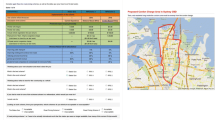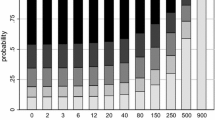Abstract
This paper combines data from a double-bounded referendum contingent valuation survey and a travel cost survey. Rather than linking the two data sets through a common utility function, as in Cameron (1992) and Niklitschek and Leon (1996), we link them through the expenditure difference function. By using the expenditure difference approach, the parameters and their standard errors for individual preferences can be easily extracted, and the trip demand function and exact welfare measure of quality improvements can be estimated. This approach is illustrated in a case study that evaluates the benefits resulting from water quality improvements in the Tamshui river system in the Taipei Metropolitan Area of Taiwan. The empirical estimation results show that the use value becomes much larger when the water quality improves to a higher level. In addition, the nonuse value makes up a large share of the total value of improving water quality; thus the nonuse value could be crucial for examining projects aimed at improving the water quality of the four rivers in the Tamshui river system.
Similar content being viewed by others
References
Adamowicz W, Louviere J, Williams M (1994) Combining revealed and stated preference methods for valuing environmental amenities. Journal of Environmental Economics and Management 26:271–292
Adamowicz W, Swait J, Boxall P, Louviere J, Williams M (1997) Perceptions versus objective measures of environmental quality in combined revealed and stated preference models of environmental valuation. Journal of Environmental Economics and Management 32:65–84
Arrow K, Solow R, Learner E, Portney P, Randner R, Schuman H (1993) Report of the NOAA panel on contingent valuation. Federal Register 58:4610–4614
Bockstael N, McConnell K (1993) Public goods as characteristics of non-market commodities. The Economic Journal 103:1244–1257
Bockstael N, Strand I, Hanemann M (1987) Time and the recreational demand model. American Journal of Agricultural Economics 69:293–302
Cameron T (1988) A new paradigm for valuing nonmarket goods using referendum data: maximum likelihood estimation by censored logistic regression. Journal of Environmental Economics and Management 15:355–379
Cameron T (1992) Combining contingent valuation and travel cost data for the valuation of nonmarket goods. Land Economics 68:302–317
Chen K, Wen Y (1995) Application of economic valuation of recreation sites: an application of the experimental forest of National I-lan Institute of Agriculture and Technology. Taiwanese Agricultural Economic Review 1:117–153
Chien Y (1994) Valuing environmental amenities with revealed and stated preference information: an application to gray whales in California. PhD dissertation, Department of Agricultural Economics, University of California, Davis
Desvousges W, Johnson R, Dunford R, Boyle K, Hudson S, Wilson K (1993) Measuring natural resources damages with contingent valuation: tests of validity and reliability. In: Husman J (ed) Contingent valuation: a critical assessment. North Holland, Amsterdam
Diamond P (1996) Testing the internal consistency of contingent valuation surveys. Journal of Environmental Economics and Management 30:337–347
Diamond P, Hausman J (1993) On contingent valuation measurement of nonuse valuation. In: Husman J (ed) Contingent valuation: a critical assessment. North Holland, Amsterdam
Diamond P, Hausman J, Loonard G, Denning M (1993) Does contingent valuation measure preference? Experimental evidence. In: Husman J (ed) Contingent valuation: a critical assessment. North Holland, Amsterdam
Hanemann W (1984) Welfare evaluations in contingent valuation experiments with discrete response data. American Journal of Agricultural Economics 66:332–341
Harrison G (1992) Valuing public goods with the contingent valuation method: a critique of Kahneman and Knetsch. Journal of Environmental Economics and Management 23:248–257
Hausman J (1981) Exact consumer’s surplus and deadweight loss. American Economic Review 71:662–676
Huang J, Haab T, Whitehead J (1997) Willingness to pay for quality improvements: should revealed and stated preference data be combined? Journal of Environmental Economics and Management 34:240–255
Kahneman D, Knetsch J (1992a) Valuing public goods: the purchase of moral satisfaction. Journal of Environmental Economics and Management 22:57–70
Kahneman D, Knetsch J (1992b) Contingent valuation and the value of public goods: reply. Journal of Environmental Economics and Management 22:90–94
Krutilla J (1967) Conservation reconsidered. American Journal of Agricultural Economics 57:777–786
LaFrance J, Hanemann W (1984) On the integration of some common demand systems. Staff paper in economics, Department of Agricultural Economics and Economics, Montana State University, Bozeman
Larson D (1991) Recovering weakly complementary preferences. Journal of Environmental Economics and Management 21:97–108
Larson D (1993) Separability and the shadow value of leisure time. American Journal of Agricultural Economics 75:572–577
Layman R, Boyce J, Criddle K (1996) Economic valuation of the Chinook salmon sport fishery of the Gulkana River, Alaska, under current and alternative management plans. Land Economics 72:113–128
Liu J (1990) The benefit estimation of water quality improvement in Tamsuei River: the application of the closed-ended contingent valuation approach. Academic Economic Papers 18:99–128
McConnell K (1990) Models for referendum data: the structure of discrete choice models for contingent valuation. Journal of Environmental Economics and Management 18:19–34
Mitchell R, Carson R (1989) Using surveys to value public goods: the contingent valuation method. Resources for the Future, Washington, DC
Nickerson C (1993) Valuing public goods: a comment on Harrison’s critique of Kahneman and Knetsch. Journal of Environmental Economics and Management 25:93–102
Nickerson C (1995) Does willingness to pay reflect the purchase of moral satisfaction? A reconsideration of Kahneman and Knetsch. Journal of Environmental Economics and Management 28:126–33
Niklitschek M, Leon J (1996) Combining intended demand and yes/no responses in the estimation of contingent valuation models. Journal of Environmental Economics and Management 31:387–402
Randall A, Hoehn J (1996) Embedding in market demand systems. Journal of Environmental Economics and Management 30:369–380
Ribaudo M, Epp D (1984) The importance of sample discrimination in using the travel cost method to estimate the benefits of improved water quality. Land Economics 60:397–403
Shaw D (1985) Three essays in the economics of recreation demand. PhD dissertation, School of Natural Resources, University of Michigan
Shaw D (1988) On-site samples’ regression: problems of non-negative integers, truncation, and endogenous stratification. Journal of Econometrics 37:211–223
Smith V (1992) Arbitrary values, good causes, and premature verdicts. Journal of Environmental Economics and Management 22:71–89
Wu P, Hsieh W (1996) Demand for environmental quality: comparing models for contingent policy referendum experiments. In: Mendelsohn R, Shaw D (eds) The economics of pollution control in the Asia Pacific. Edward Elgar, Aldershot, UK, 226–252
Author information
Authors and Affiliations
About this article
Cite this article
Shaw, D., Chien, YL. & Lin, YM. Alternative approach to combining revealed and stated preference data: evaluating water quality of a river system in Taipei. Environ Econ Policy Stud 2, 97–112 (1999). https://doi.org/10.1007/BF03353905
Received:
Accepted:
Published:
Issue Date:
DOI: https://doi.org/10.1007/BF03353905




